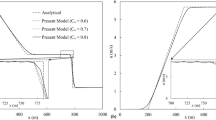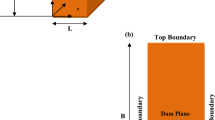Abstract
Streamline simulation is a powerful tool that can be used for full field forecasting, history matching, flood optimization, and displacement visualization. This paper presents the development and the application of a new semi-analytical streamline simulation method in the near-wellbore region in polar/cylindrical coordinate systems. The main objective of this paper is to study the effects of the permeability heterogeneity and well completion details in the near-wellbore region. These effects dictate the streamline geometries, which in turn influence well productivity. Previous streamline applications used a constant flow rate for each stream tube. In this paper, streamline simulation is performed under the assumption of constant pressure boundaries, which is a novel and non-trivial extension of streamline simulation. Solutions are constructed by treating each stream tube as a flow unit by invoking analytical solutions for such geometries. In addition, visualization experiments are conducted to investigate the effect of the heterogeneity. Two-dimensional waterflooding visualization experiments in radial porous media are performed with constant pressure boundaries. The streamline simulator is applied to history match the relative permeabilities using these experiments, thereby validating the new near-well streamline method.
Similar content being viewed by others
References
Batycky, R.P.: A three-dimensional two-phase field scale streamline simulator. doctoral dissertation. Stanford University, Department of Petroleum Engineering, Stanford (1997)
Bratvedt, F., Gimse, T., Tegnander, C.: Streamline computations for porous media flow including gravity. Transport in Porous Media, pp. 63–78 (1996)
Brock, D.C., Orr, F.M., Jr.: Flow Visualization of Viscous Fingering in Heterogeneous Porous Media. SPE (1991)
Buckley, S.E., Leverett, M.C.: Mechanism of fluid displacement in sands. Trans. AIME 146(01), 107–116 (1942)
Butler, R.M., Mokrys, I.J.: Recovery of heavy oils using vaporized hydrocarbon solvents: further development of the VAPEX process. JCPT 32(6), 56–62 (1993)
Chatenever, A., Calhoun, J.C.: Visual examinations of fluid behaviour in porous media-part I. Soc. Pet. Eng. 4, 06 (1952)
Chatzis, I., Morrow, N., Lim, H.T.: Magnitude and detailed structure of residual oil saturation. Soc. Pet. Eng. J. 23, 311–325 (1983)
Chen, J.D.: Radial viscous fingering patterns in hele shaw cell. Exp. Fluids 5, 363–371 (1987)
Cheng, H., Osako, I., Datta-Gupta, A., King, M.J.: A rigorous compressible streamline formulation for two and three-phase black-oil simulation. Society of Petroleum Engineers (2005). https://doi.org/10.2118/96866-MS
Cheng, H., Osako, I., Datta-Gupta, A., King, M.J.: A rigorous compressible streamline formulation for two and three-phase black-oil simulation. Society of Petroleum Engineers (2006). https://doi.org/10.2118/96866-PA
Chuoke, R.L., van Meurs, P., van der Poel, C.: The instability of slow, immiscible, viscous liquid-liquid displacements in permeable media. Pet. Trans. AIME 216(1959), 188–194 (1959)
Corey, A.T.: The interrelation between gas and oil relative permeabilities. Producers Mon. 19(1), 38–41 (1954)
Datta-Gupta, A., King, M.J.A.: Semianalytical approach to tracer flow modelling in heterogeneous permeable media. Advances in Water Resources, pp. 9–14 (1995)
Datta-Gupta, A., King, M.J.: Streamline simulation: theory and practice. Society of Petroleum Engineers, Vol. 11 (2007)
Dawe, R.A., Wheat, M.R., Bidner, M.S.: Experimental investigation of capillary pressure effects on immiscible displacement in lensed and layered porous media. Transp. Porous Media 7(1), 83–101 (1992)
Emanuel, A.S., Alameda, G.K., Behrens, R.A., Hewett, T.A.: Reservoir performance prediction methods based on fractal geostatics. SPE Reservoir Engineering, pp. 311–318 (1989)
Fay, C.H., Pratts, M.: The application of numerical methods to cycling and flooding problems. 3rd World Petroleum Congress (1951)
Hadibeik, H., Pour, L.A., Torres-Verdin, C., Sephernoori, K., Shabro, V.: 3D Multiphase Streamline-Based Method for Interpretation of Formation Tester Measurements Acquired in Vertical and Deviate Wells. Society of Petroleum Engineers, Denver (2011)
Huang, H., Zhang, F., Callahan, P., Ayoub, J.: Fluid Injection Experiments in 2D Porous Media. SPE Joural (2012)
James, L.A., Chatzis, I.: Details of gravity drainage of heavy oil during vapor extraction. In: International Symposium of the Society of Core Analysts (2004)
James, L.A., Rezaei, N., Chatzis, I.: VAPEX, warm VAPEX and hybrid VAPEX-the state of enhanced oil recovery for in situ heavy oils in Cana. Journal of Canadian Petroleum Technology, Waterloo (2008)
Johansen, T.E., James, L.A.: Solution of multi-component, two-phase Riemann problems with constant pressure boundaries. J. Eng. Math. 96(1), 23–35 (2015). Springer Verlag
Johansen, T.E., James, L.A., Liu, X.: Fractional flow theory for constant pressure boundaries. a generalization of the buckley-leverett theory for flow of two immiscible phases, Society of Petroleum Engineering Journal (2016)
Johansen, T.E., Liu, X.: Solution of riemann problem for hyperbolic systems of conservation laws modeling two phase flow in general stream tube geometries. Springer Verlag, Journal of Engineering Mathematics (2016)
Juanes, R., Matringe, S.F.: Unified formulation for high-order streamline tracing on two-dimensional unstructured grids. J. Sci. Comput. 38(1), 50–73 (2009)
Khorshidian, H., James, L.A., Butt, S.D.: Corner oil film elevation above the gas-oil interface in water-wet capillaries. Presented at the Society of Core Analysts Symposium, St John’s (2015)
Lagrange, J.L.: Mémoire sur la théorie du mouvement des fluids, pp 695–748. Oevres de Lagrange, Tome IV (1781)
Lake, L.W., Johnston, J.R., Stegemeier, G.L.: Simulation and performance prediction of a large-scale surfactant/polymer project. Soc. Pet. Eng. J. 21, 731–739 (1981)
LeBlanc, J.L., Caudle, B.H.: A streamline model for secondary recovery. Soc. Pet. Eng. J. 1, 7–12 (1971)
Mathews, J.L., Emanuel, A.S., Edwards, K.A.: Fractal methods improve mitsue miscible predictions. Journal of Petroleum Technology, pp. 1136-1149 (1989)
Matringe, S.F., Gerritsen, M.G.: On accurate tracing of streamlines. SPE Annual Technical Conference and Exhibition. Society of Petroleum Engineers (2004)
Martin, J.C., Woo, P.T., Wagner, R.E.: Failure of Stream Tube Methods to Predict Waterflood Performance of An Isolated Inverted Five-Spot At Favorable Mobility Ratios. J. Pet. Technol. 25(02), 151–153 (1973)
Martin, J.C., Wegner, R.E.: Numerical solution of multiphase, two-dimensional incompressible flow using streamtube relationships. Soc. Pet. Eng. J. 19(5), 313–323 (1979)
Moayedi, M., James, L.A., Johansen, T.: Pore scale investigation of carbonated water injection with and without gravity, Colorado (2016)
Muskat, M., Wyckoff, R.: A theoretical analysis of waterflooding net-works. Trans. AIME 107, 62–77 (1934)
Muskat, M.: The flow of homogeneous fluid through porous media. International human resources development corporation. ISSN: 0038-075X (1937)
Pasari, U., Arihara, N.: Application of streamline method to hot water-flooding simulation for heavy oil recovery. Paper SPE 93149 presented at the SPE Asia Pacific Oil and Gas Conference and Exhibition, Jakarta, Indonesia (2005)
Oduntan, A.R., Chatzis, I.: Heavy oil recovery using the VAPEX Process: Scale-Up Issues. Canadian International Petroleum Conference, Calgary, Alberta, paper 2001–127 (2001)
Paterson, L.: Radial Fingering in a Hele Shaw Cell. J. Fluid Mech. 113, 513–529 (1981)
Peddibhotla, S., Datta-Gupta, A., Xue, G.: Multiphase streamline modeling in three dimensions: further generalizations and a field application. SPE Reservoir Simulation Symposium Dallas. Society of Petroleum Engineers, TX (1997)
Pitts, G.N., Crawford, P.B.: Low areal sweep efficiencies in flooding heterogeneous tock. 9th Biennial Symposium, Production Techniques, Witchita Falls. Society of Petroleum Engineers, TX (1970)
Pollock, D.W.: Semianalytical computation of path lines for finite-difference models. Ground Water 26(6), 743–750 (1988)
Rodriguez, P.G., Segura, M.K.C., Moreno, F.J.M.: Streamline methodology using an efficient operator splitting for accurate modelling of capillarity and gravity effects SPE Reservoir Simulation Symposium (2003)
Roti, F., Dawe, R.A.: Modelling fluid flow in cross-bedded sections. Trans. Porous Media 12, 143–159 (1993)
Silva, J.M., Dawe, R.A.: Effects of permeability and wettability heterogeneities on flow in porous media. SPE Latin American and Caribbean Petroleum Engineering Conference, Port-of-Spain (2003)
Skinner, J.: Near wellbore streamline modelling for advanced well completions. Master Thesis, Memorial University (2011)
Skinner, J., Johansen, T.E.: Near wellbore streamline modelling: its novelty, application, and potential use. International Symposium and Exhibition on Formation Damage Control Lafayette, Louisiana (2012)
Tang, R.W., Behrens, R.A., Emanuel, A.S.: Reservoir studies using geostatistics to forecast performance. SPE Symposium on Reservoir Simulation Houston, TX (1989)
Thiele, M.R.: Modeling multiphase flow in heterogeneous media using streamtubes. Doctoral dissertation. Stanford University, Stanford (1994)
Thiele, M.R.: Streamline simulation 6th international forum on reservoir simulation. Schloss Fuschl, Austria (2001)
Thiele, M.R., Batycky, R.P., Fenwick, D.H.: Streamline simulation for modern reservoir-engineering workflows. Journal of Petroleum Technology Distinguished Author Series, (64–70) (2010)
Valsecch, P., McDuff, D., Chang, D.L., Huang, H., Burdette, J., Long, T., Karmonik, C.: Simulation and visualization of near-well flow. Society of Petroleum Engineers (2012)
Author information
Authors and Affiliations
Corresponding author
Rights and permissions
About this article
Cite this article
Tang, X., James, L.A. & Johansen, T.E. A new streamline model for near-well flow validated with radial flow experiments. Comput Geosci 22, 363–388 (2018). https://doi.org/10.1007/s10596-017-9697-1
Received:
Accepted:
Published:
Issue Date:
DOI: https://doi.org/10.1007/s10596-017-9697-1




